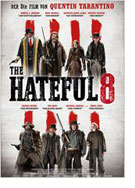

Opening 28 Jan 2016
Directed by:
Quentin Tarantino
Writing credits:
Quentin Tarantino
Principal actors:
Samuel L. Jackson, Kurt Russell, Jennifer Jason Leigh, Walton Goggins, Demian Bichir
Quentin Tarantino is back with a vengeance. His eighth film is a fierce, intense homage to the Old West post American Civil War’s end (1865). Hate brewed strong in the hearts of scoundrels and scallywags still loyal to prejudices that caused the war, and those caught in-between.
Unfolding in eight chapters, each is an intense and integral part of the whole. Wyoming. A stagecoach pounding along a deep-winter landscape—“a blizzard’s been on our ass the last three hours”—is forced to stop. A lone man sits in the road. Bounty hunter John Ruth (Russell), chained to disreputable fugitive Daisy Domergue (Jason Leigh), recognizes former Major Marquis Warren (Jackson), an infamous, ruthless colleague. Warning against wasting time, O.B. (Parks) firmly holds the six horses in reign when Chris Mannix (Goggins), claiming to be the new Sheriff of Red Rock—their destination—joins them. Galloping on, they are on tenterhooks to reach the intermediate Minnie’s Haberdashery. But, Minnie (Gourrier) and Sweet Dave (Gene Jones) are gone, leaving the unknown Bob (Bichir) in charge. Within, the group comes across more strangers: Red Rock’s genial hangman, a standoffish cowpoke, and a reticent former Confederate General (Roth, Dern, Madsen). As the howling pitch of the whiteout intensifies, its eight captives warily circle one another realizing Red Rock may lie out of their reach.
Victoria Thomas’ casting is brilliant. The cast epitome of each character is impressive: Russell and Jackson’s characters survive by using their wits and instincts, albeit one is cleverer; Jason Leigh’s gal is objectionable, depraved, has sexy grit, yet somehow is digestible; Mannix and Dern maneuver bigotry with aplomb albeit, again, one has horse-sense; Roth, Madsen, Bichir, Channing Tatum as Jody, Gourrier, et al. are fantastic. To say more is to give the plot away, which none should do.
Quentin Tarantino takes time telling his stories; his screenplay scrutinizes human nature, has political overtones, and is tightly constructed with brilliant, emotional dialogue the cast conveys with honesty. It took patience and boldness getting this film made. A good year after finishing the script, on April 19, 2014 in a downtown Los Angeles theatre, The Hateful Eight had a distinctive premier. The majority of the main ensemble sat on stage with Tarantino, and read the screenplay. Their reward was a standing ovation from an audience of more than 1,600 fans. Russell said, “It was something special” and that the actors responded to the fever-pitch energy in the theatre. “It was a rare mix of film and theatre. … gigantic fun…” added Roth, while Goggins remembers “the audience were blown away.” Jackson thought, “After this reception how can he (Tarantino) not make this film.” Eight months later, on ranchland in Wilson Mesa near Telluride in the Colorado Rockies, filming began.
Tarantino chose to film using 70mm Ultra Panavision film; Khartoum, 1966 was the last film shot using it, and it is only available from a handful of suppliers. But, the difference between digital is incomparable. Using the 70mm-format, not only is there more information in-frame, e.g. all eight actors at Minnie’s, the material is deeper, with color and light that give a spectacular effect. Tarantino and Robert Richardson are grateful to Panavision; Richardson, applying uncommon framing, met cinematographic challenges. There are two versions of this film: for normal theatres a 167-minute version; the 70-mm roadshow 187-minute version has a 12-minute intermission with an overture by Ennio Morricone. Initially, Morricone told Tarantino prior commitments would prevent him from scoring an extra 12 minutes. The next day however, he surprised the director with the additional piece. How refreshing to hear Morricone’s distinctive, contrasting music (for which he won the Best Film Music Golden Globe), supplemented with Tarantino’s—his passionate music literacy and library is well-known—song choices.
Fred Raskin also met 70mm demands: the editing studio was colder than where they filmed, and his honed skill edits picture/music in synchronization. Production designer Yohei Taneda is a huge Western fan (favorite is Shane, 1953) and was delighted to add his personal touch to every detail. At the Haberdashery—combination drugstore, bar and restaurant—after filming twelve weeks, one could open a drawer and notice something they had missed seeing. Courtney Hoffman’s costumes are genuine and iconic (a trademark of Tarantino films), as well as functional. To boot is Richard L. Johnson’s art direction, and set decoration’s Rosemary Brandenburg’s follow-through; audiences are visually rewarded by the teams’ obvious research and enthusiasm.
Quentin Tarantino’s films have a proclivity toward killings (minimal here compared to Kill Bill, Vol. 1 and 2, 2003 and 2004), and authenticity, which quite often is the antithesis of political correctness. Forewarned is to be forearmed – take earplugs and blinders. Peppered with wide-ranging red herrings, The Hateful Eight, as in any intriguing whodunit, waits until the bitter end to reveal exactly who has done what to whom. It will not be surprising that Tarantino’s eighth film has crossover appeal and lasting power. (Marinell Haegelin)